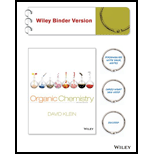
(a)
Interpretation:
Isoprene units in the given set of compounds need to be circled.
Concept introduction:
Terpenes are naturally occurring compounds which share a common feature. All terpenes are thought to be assembled from isoprene units having five carbon atoms. So the structure of terpenes has the carbon atoms in multiples of five only.

The isoprene units are identified by following few steps namely,
- Identify the number of isoprene units
- Look for methyl group
- Trial and error to find isoprene unit
To identify: the isoprene units in bisabolene
(b)
Interpretation:
Isoprene units in the given set of compounds need to be circled.
Concept introduction:
Terpenes are naturally occurring compounds which share a common feature. All terpenes are thought to be assembled from isoprene units having five carbon atoms. So the structure of terpenes has the carbon atoms in multiples of five only.

The isoprene units are identified by following few steps namely,
- Identify the number of isoprene units
- Look for methyl group
- Trial and error to find isoprene unit
To identify: the isoprene units in flexibilene
(c)
Interpretation:
Isoprene units in the given set of compounds need to be circled.
Concept introduction:
Terpenes are naturally occurring compounds which share a common feature. All terpenes are thought to be assembled from isoprene units having five carbon atoms. So the structure of terpenes has the carbon atoms in multiples of five only.

The isoprene units are identified by following few steps namely,
- Identify the number of isoprene units
- Look for methyl group
- Trial and error to find isoprene unit
To identify: the isoprene units in humulene
(d)
Interpretation:
Isoprene units in the given set of compounds need to be circled.
Concept introduction:
Terpenes are naturally occurring compounds which share a common feature. All terpenes are thought to be assembled from isoprene units having five carbon atoms. So the structure of terpenes has the carbon atoms in multiples of five only.

The isoprene units are identified by following few steps namely,
- Identify the number of isoprene units
- Look for methyl group
- Trial and error to find isoprene unit
To identify: the isoprene units in vitamin A
(e)
Interpretation:
Isoprene units in the given set of compounds need to be circled.
Concept introduction:
Terpenes are naturally occurring compounds which share a common feature. All terpenes are thought to be assembled from isoprene units having five carbon atoms. So the structure of terpenes has the carbon atoms in multiples of five only.

The isoprene units are identified by following few steps namely,
- Identify the number of isoprene units
- Look for methyl group
- Trial and error to find isoprene unit
To identify: the isoprene units in geraniol
(f)
Interpretation:
Isoprene units in the given set of compounds need to be circled.
Concept introduction:
Terpenes are naturally occurring compounds which share a common feature. All terpenes are thought to be assembled from isoprene units having five carbon atoms. So the structure of terpenes has the carbon atoms in multiples of five only.

The isoprene units are identified by following few steps namely,
- Identify the number of isoprene units
- Look for methyl group
- Trial and error to find isoprene unit
To identify: the isoprene units in sabinene
Want to see the full answer?
Check out a sample textbook solution
Chapter 26 Solutions
Organic Chemistry, Binder Ready Version
- Show the mechanism steps to obtain the lowerenergy intermediate: *see imagearrow_forwardSoap is made by the previous reaction *see image. The main difference between one soap and another soap isthe length (number of carbons) of the carboxylic acid. However, if a soap irritates your skin, they mostlikely used too much lye.Detergents have the same chemical structure as soaps except for the functional group. Detergentshave sulfate (R-SO4H) and phosphate (R-PO4H2) functional groups. Draw the above carboxylic acidcarbon chain but as the two variants of detergents. *see imagearrow_forwardWhat are the reactions or reagents used? *see imagearrow_forward
- The two pKa values of oxalic acid are 1.25 and 3.81. Why are they not the same value? Show the protontransfer as part of your explanation. *see imagearrow_forwardасть Identify all the bonds that gauche interact with C-OMe in the most stable conformation of the above compound.arrow_forwardPredict the reactants used in the formation of the following compounds using Acid-Catalyzed dehydration reactionarrow_forward
- Can I please get help with this?arrow_forward.. Give the major organic product(s) for each of the following reactions or sequences of reactions. Show ll relevant stereochemistry [3 ONLY]. A H Br 1. NaCN 2 NaOH, H₂O, heat 3. H3O+ B. CH₂COOH 19000 1. LiAlH4 THF, heat 2 H₂O* C. CH Br 1. NaCN, acetone 2 H3O+, heat D. Br 1. Mg. ether 3. H₂O+ 2 CO₂ E. CN 1. (CH) CHMgBr, ether 2 H₂O+arrow_forwardAssign this COSY spectrumarrow_forward
 ChemistryChemistryISBN:9781305957404Author:Steven S. Zumdahl, Susan A. Zumdahl, Donald J. DeCostePublisher:Cengage Learning
ChemistryChemistryISBN:9781305957404Author:Steven S. Zumdahl, Susan A. Zumdahl, Donald J. DeCostePublisher:Cengage Learning ChemistryChemistryISBN:9781259911156Author:Raymond Chang Dr., Jason Overby ProfessorPublisher:McGraw-Hill Education
ChemistryChemistryISBN:9781259911156Author:Raymond Chang Dr., Jason Overby ProfessorPublisher:McGraw-Hill Education Principles of Instrumental AnalysisChemistryISBN:9781305577213Author:Douglas A. Skoog, F. James Holler, Stanley R. CrouchPublisher:Cengage Learning
Principles of Instrumental AnalysisChemistryISBN:9781305577213Author:Douglas A. Skoog, F. James Holler, Stanley R. CrouchPublisher:Cengage Learning Organic ChemistryChemistryISBN:9780078021558Author:Janice Gorzynski Smith Dr.Publisher:McGraw-Hill Education
Organic ChemistryChemistryISBN:9780078021558Author:Janice Gorzynski Smith Dr.Publisher:McGraw-Hill Education Chemistry: Principles and ReactionsChemistryISBN:9781305079373Author:William L. Masterton, Cecile N. HurleyPublisher:Cengage Learning
Chemistry: Principles and ReactionsChemistryISBN:9781305079373Author:William L. Masterton, Cecile N. HurleyPublisher:Cengage Learning Elementary Principles of Chemical Processes, Bind...ChemistryISBN:9781118431221Author:Richard M. Felder, Ronald W. Rousseau, Lisa G. BullardPublisher:WILEY
Elementary Principles of Chemical Processes, Bind...ChemistryISBN:9781118431221Author:Richard M. Felder, Ronald W. Rousseau, Lisa G. BullardPublisher:WILEY





